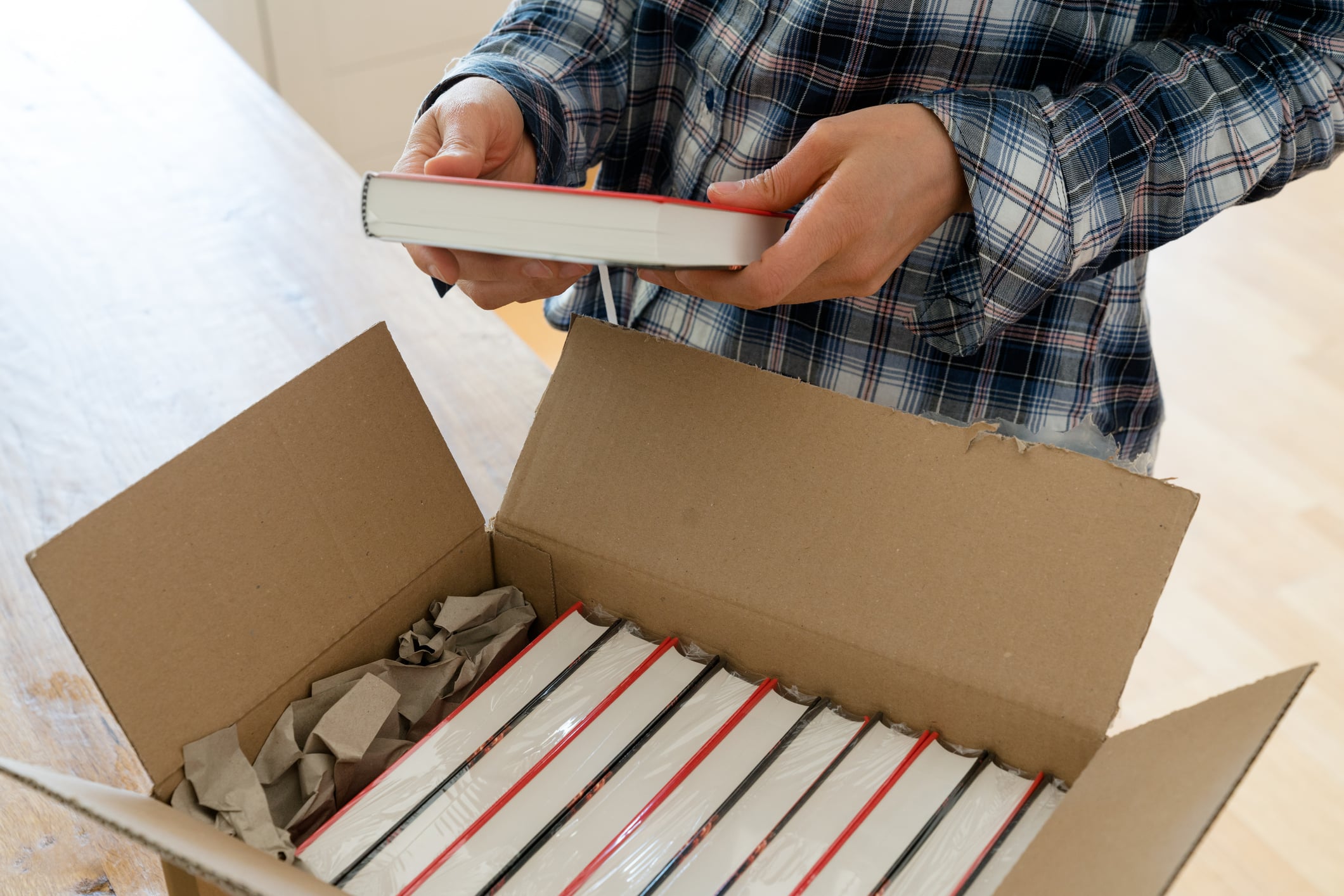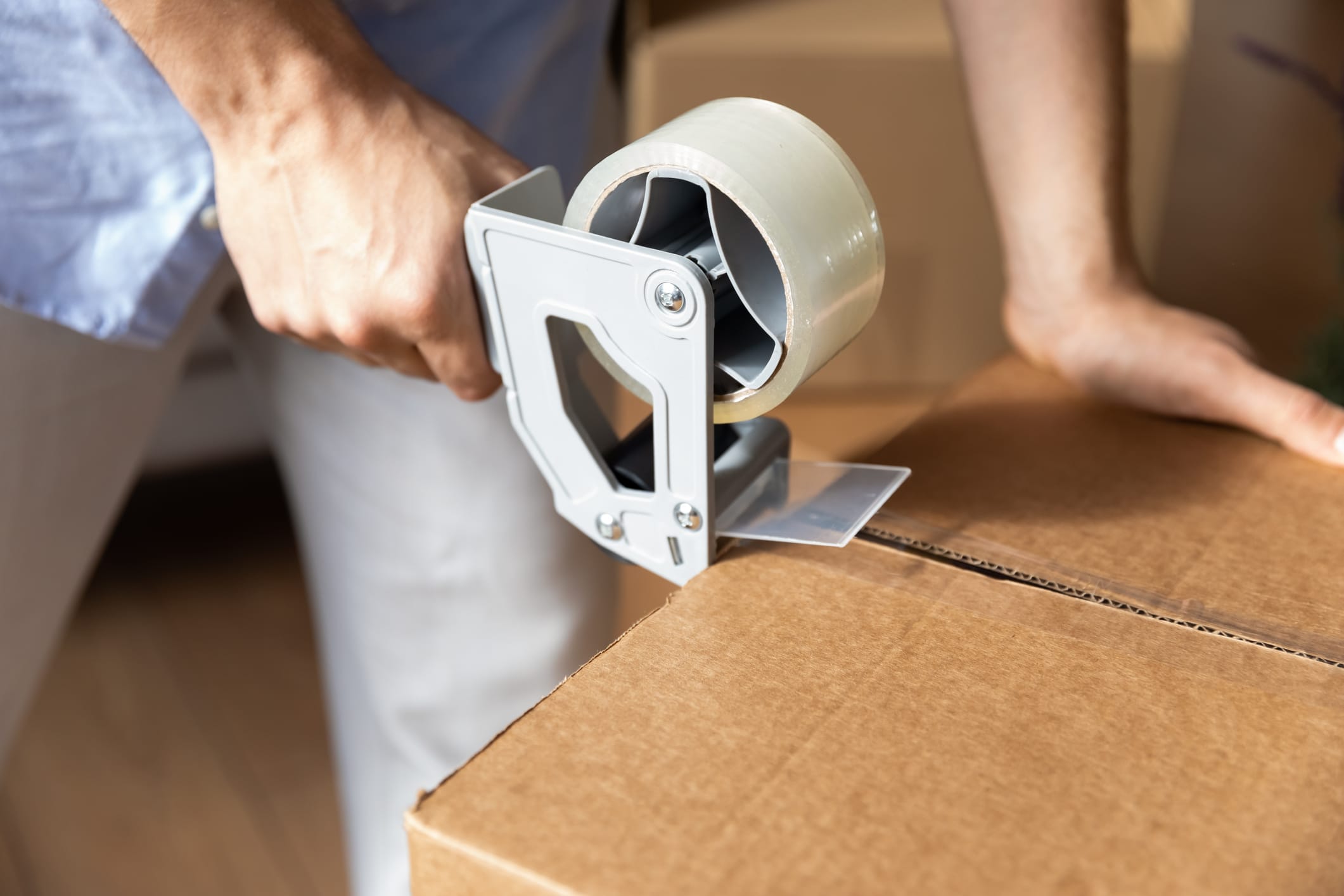(Updated October 27, 2024)
While it can be tempting to throw your books in a box and be done with it — books are durable, right? — careless packing can leave your books in rough shape if you don’t take some precautions.
For the sake of your beloved library, we put together some tips from the pros on how to pack books for moving, especially if you’re moving to another state or across the country. A few easy precautions will keep your books safe throughout your move.
What to Do Before Packing Books for Moving
Minimize Your Collection
Avoiding a cracked spine is good advice for humans and books alike. And since books are some of the heaviest items you’ll pack when you move, lightening the load is a smart idea.
Shrinking your collection means less physical strain on your body if you’re doing the move yourself or reduced moving costs if you hire professionals. If you’re downsizing your home, getting rid of some books will also help free up more space.
To begin, sort your books and get rid of any duplicates, books you also have in digital format, and books you won’t ever read again. Instead of trashing books you no longer need, consider:
Donating them to a second-hand store, library, or school
Stocking the Little Free Libraries in your area
Giving them away to friends, or having a book giveaway party
Recycling them (f books are hardcover, remove and throw away the binding first)
Organize your collection before packing books for moving
It’s hard to know how many boxes you’ll need if you don’t know how many books you’re going to pack up, so start organizing. Separate each of the following into piles: hardcover, paperback, oversized, and antique/heirloom/collectible (or whatever other piles make sense for your unique collection).

Gather your packing supplies
As you get started, you’ll realize that the best boxes for books are small- and medium-sized.
Boxes full of books can quickly become too heavy to handle, so using smaller boxes will help limit overall weight. Paperback and hardcover books pack easily into these box sizes, while oversized and collectible books may require a more strategic approach.
No matter what types of books you’ve got, however, the maximum weight per box shouldn’t exceed 35–40 pounds. Use this checklist to gather materials for packing:
Small to medium-sized boxes
Strong packing tape and dispenser
Permanent marker
Packing paper
Bubble wrap
Dust-free cleaning cloth
Pieces of cardboard small enough to fit in boxes
Acid-free paper for packing collectible books (optional)
The best boxes for moving books
If you plan to buy boxes, you can get ones made specifically for books. (These typically measure 12x12x12 inches.)
Otherwise, any sturdy, small- or medium-sized cardboard boxes between 1.5 and 3 cubic feet will work. If you want extra durability and support, double-walled cardboard boxes are a great option.
Secure your moving boxes
Once you’ve purchased or collected small to medium-sized boxes, do the following:
Tape the bottom of each box with strong packing tape, reinforcing by adding extra layers of tape to the bottom seam. Use the "H" method (tape along the seam and the edges) for more reinforcement.
Line the inside bottom of each box with several layers of packing paper.
If you’re packing collectible or heirloom books, use acid-free paper instead. For added protection, line the box bottom with packing material or styrofoam. This is especially important for cross-country moving or long-distance moves, when books may remain boxed for extended periods.
Q: What is the best way to move with lots of books?A: Can’t seem to cut down your book collection? Packing lots of books doesn’t have to be complicated. Sort them by category and use small- to medium-sized boxes as you pack, to avoid overloading. Label each box by category, tape generously, and load boxes into the moving van using a wheeled dolly. |

How to Pack Books for Moving: Paperback, Hardcover, and More
The books you own travel best when paired with similar books — we’re talking about format here, not subject matter — so think about matching books by their dimensions.
You’ll also want to be diligent about labeling and packing books for moving. Because you’re grouping books by size and not more traditional categories like author or subject, you’ll need detailed labeling to unpack efficiently.
The brief video below will give you a primer on how to pack books for moving, but this whole section will provide detailed instructions on how to pack books of each type.
How to Pack Books for Moving: Paperback Books
Group similar-sized paperbacks together, and prepare to pack according to size.
Place books flat to avoid bending the spines, or if you want to pack them upright, face the spines downward (pages upward) to prevent pages from bending.
Fill any gaps with packing paper or bubble wrap to prevent shifting.
Seal and label as “Paperback books,” and add the category and room to the label if desired.
How to pack books for moving: Hardcover books
Group similar-sized hardcovers together, and prepare to pack according to size.
Pack books upright, facing the spine sides against the walls of the box.
If there are gaps, fill them with packing paper or bubble wrap to prevent shifting.
Seal and label as “Hardcover books,” and add the category and destination room to the label if desired.
Should I pack books spine upward or spine downward?
The best way to pack books in a box is spine downward. This will both minimize pressure on the binding, and prevent pages from bending. If you still aren’t sure how to pack books for moving, keep reading …
How to Pack Books for Moving: Oversized Books
Because oversized books are generally heavier, plan to pack just a few in each box.
Wrap each oversized book with packing paper or bubble wrap to prevent books from rubbing against each other and scratching. This is especially important for coffee table–type books with dust jackets that you want to keep in pristine condition.
Fill any gaps with packing paper or bubble wrap to prevent shifting.
Seal and label as “Oversized Books,” and add the category and destination room to the label if desired.
How to Pack Books for Moving: Antique, Heirloom, Collectible Books
Clean each book gently with a dust-free cloth before packing.
Wrap each antique, heirloom, or collectible book with acid-free paper.
Wrap each antique, heirloom, or collectible book with bubble wrap to protect corners.
Pack books upright, and place a piece of cardboard between them for added protection. If books are oversized, follow the same instructions, but lay them flat in the box.
Fill any gaps with packing paper or bubble wrap to prevent shifting.
Seal and label as either “Antique Books,” “Heirloom Books,” or “Collectible Books,” then write the word “Fragile” on the box, adding the category and destination room to the label if desired.

Do’s and Don’ts When Packing Books for Moving
DO handle books with care to prevent injuries and keep them from getting damaged.
DO use a moving dolly when possible, to reduce the need to lift heavy boxes.
DO hire a moving service to pack your books if you don’t have time or you have lifting restrictions.
DON’T bend and lift at the waist when picking up boxes. Bend at the knees, keep your back straight, and keep the load close to your body.
DON’T stack book boxes on top of non-book boxes. They’re too heavy!
DON’T use large boxes — they aren’t the best boxes for moving books. They’re too heavy when filled!
DON’T expose books to extreme temperatures. They could bend or warp.
Q: What’s the best way to pack books when moving?The best way to pack books for moving is to use small boxes, and pack books spine side down. Pack flat or upright to protect spines and be sure to wrap rare or valuable books in acid-free paper or bubble wrap for extra protection. Also, avoid overpacking to prevent box breakage. |

Moving Books Like a Pro
Learning how to pack books for moving might add a little time to your process, but the reward is that your book collection will be intact and organized at the end of your move.
Don’t have time (or the lower-back strength) to pack your books? Let Colonial Van Lines take care of your long-distance move, and we’ll make sure your library is packed, loaded, and transported safely.
Take advantage of our many years of experience and contact us to help you move. Request your free quote here.

